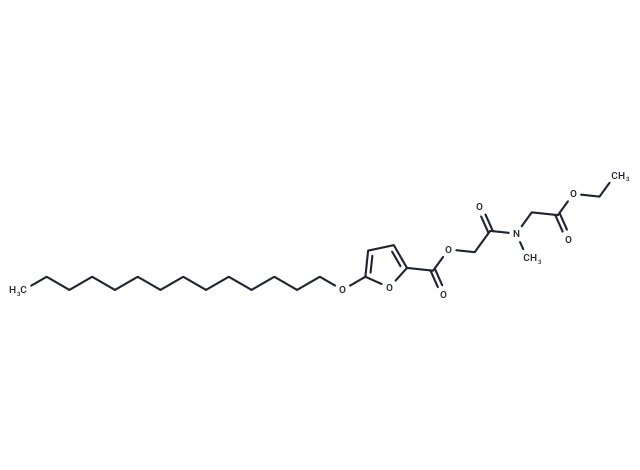Shopping Cart
Remove All Your shopping cart is currently empty
Your shopping cart is currently empty
Olumacostat glasaretil is a small molecule inhibitor of acetyl coenzyme A carboxylase (ACC). It has been used in trials studying the treatment of Acne Vulgaris.

| Pack Size | Price | USA Warehouse | Global Warehouse | Quantity |
|---|---|---|---|---|
| 1 mg | $44 | In Stock | In Stock | |
| 5 mg | $97 | In Stock | In Stock | |
| 10 mg | $147 | In Stock | In Stock | |
| 25 mg | $279 | In Stock | In Stock | |
| 50 mg | $478 | In Stock | In Stock | |
| 100 mg | $697 | In Stock | In Stock | |
| 200 mg | $992 | In Stock | In Stock | |
| 1 mL x 10 mM (in DMSO) | $98 | In Stock | In Stock |
| Description | Olumacostat glasaretil is a small molecule inhibitor of acetyl coenzyme A carboxylase (ACC). It has been used in trials studying the treatment of Acne Vulgaris. |
| In vitro | Acetyl coenzyme A carboxylase plays a pivotal role in regulating the initial, critical step of fatty acid biosynthesis. Olumacostat glasaretil effectively impedes de novo lipid formation in both primary and transformed human sebocytes, significantly diminishing fatty acid synthesis to equal or lower than baseline levels at a concentration of 3 μM. Moreover, cultures of SEB-1 cells exhibit a marked reduction, between 85% to 90%, in ^14C-acetate incorporation when treated with 20 μM of olumacostat glasaretil, relative to untreated controls. At a lower dose of 3 μM, olumacostat glasaretil notably decreases the accumulation of several lipids in sebocytes, including triacylglycerol, cholesteryl/wax ester, diacylglycerol, cholesterol, and phospholipids by approximately 86%, 57%, 51%, 39%, and 37%, respectively[1]. |
| In vivo | Olumacostat glasaretil, a pro-drug of the ACC inhibitor 5-(tetradecyloxy)-2-furoic acid (TOFA), is designed for improved in vivo delivery. Unlike TOFA, topical application of olumacostat glasaretil notably decreases the size of sebaceous glands in hamster ears. HPLC analysis of hamster ear extracts indicates that treatment with olumacostat glasaretil raises ACC levels and increases the acetyl-CoA to free CoA ratio in subjects, suggesting enhanced fatty acid oxidation linked to ACC inhibition. Furthermore, MALDI imaging demonstrates that olumacostat glasaretil, when applied to Yorkshire pig ears, predominantly accumulates in sebaceous glands compared to the adjacent dermis. After 12 weeks, olumacostat glasaretil treatment results in significant decreases in both inflammatory and noninflammatory lesions, with a higher percentage of patients achieving at least a 2-grade improvement in investigator global assessment score compared to those treated with a placebo vehicle. |
| Cell Research | Primary human sebocytes are grown to confluence in 96-well plates in sebocyte growth medium and stimulated with 1 μM human insulin and 1 μM liver X receptor (LXR) agonist T0901317 in the presence of increasing concentrations of TOFA or olumacostat glasaretil in culture medium containing 0.1% DMSO. After 24 hours, stimulation/treatment medium is removed and test articles are reapplied in labeling medium containing [14C]-acetate. Following an additional 16 hours, cells are harvested using trypsin/EDTA. Lipid extracts are prepared and the amount of [14C]-acetate incorporation is determined by liquid scintillation as a measure of de novo fatty acid synthesis[1]. |
| Molecular Weight | 481.62 |
| Formula | C26H43NO7 |
| Cas No. | 1261491-89-7 |
| Smiles | CCCCCCCCCCCCCCOc1ccc(o1)C(=O)OCC(=O)N(C)CC(=O)OCC |
| Relative Density. | 1.057 g/cm3 (Predicted) |
| Storage | Powder: -20°C for 3 years | In solvent: -80°C for 1 year | Shipping with blue ice/Shipping at ambient temperature. | |||||||||||||||||||||||||||||||||||
| Solubility Information | H2O: < 0.1 mg/mL (insoluble) DMSO: 125 mg/mL (259.54 mM), Sonication is recommended. | |||||||||||||||||||||||||||||||||||
| In Vivo Formulation | 10% DMSO+40% PEG300+5% Tween 80+45% Saline: 4 mg/mL (8.31 mM), Sonication is recommended. Please add the solvents sequentially, clarifying the solution as much as possible before adding the next one. Dissolve by heating and/or sonication if necessary. Working solution is recommended to be prepared and used immediately. The formulation provided above is for reference purposes only. In vivo formulations may vary and should be modified based on specific experimental conditions. | |||||||||||||||||||||||||||||||||||
Solution Preparation Table | ||||||||||||||||||||||||||||||||||||
DMSO
| ||||||||||||||||||||||||||||||||||||
| Size | Quantity | Unit Price | Amount | Operation |
|---|

Copyright © 2015-2025 TargetMol Chemicals Inc. All Rights Reserved.